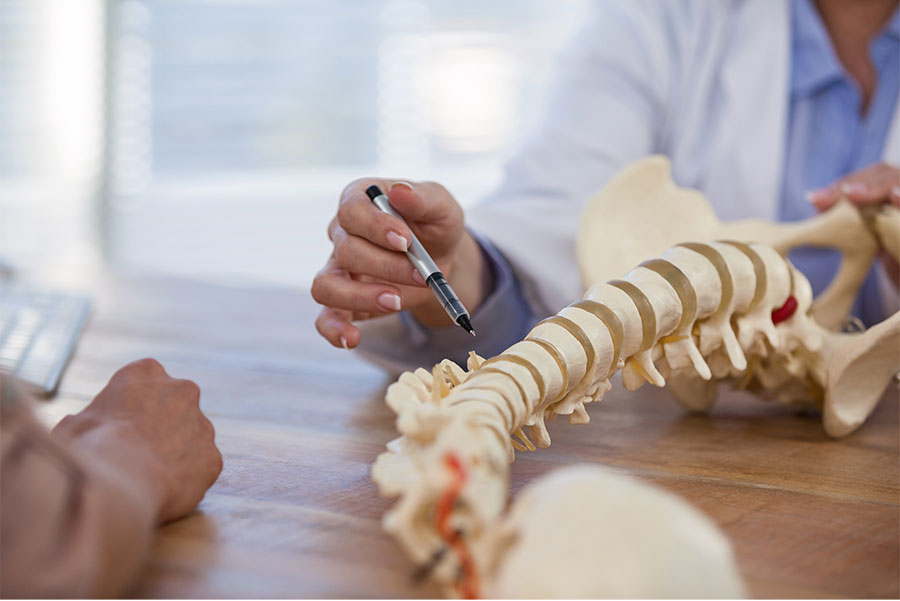
The Bone Health Clinic is for patients at risk for fractures and osteoporosis.
What is osteoporosis?
Osteoporosis is a condition causing the bones to become weak and brittle. This disease happens when you lose too much bone, make too little bone, or both. As a result, your bones may break from a minor fall or, in serious cases, even from sneezing or bumping into furniture.
When a bone break occurs due to a fall from standing height or less, the cause of the break is usually the result of osteoporosis or low bone mass. The most common places where broken bones occur are the spine, hip, and wrist, but any bone may be affected.
Who gets osteoporosis?
There are a variety of factors, controllable and uncontrollable, that put you at risk for developing osteoporosis.
Uncontrollable risk factors:
- 50 years old or older
- Female
- Menopause
- Family history of osteoporosis
- Low body weight/being small and thin
Controllable risk factors:
- Inadequate calcium and vitamin D
- Low consumption of fruits and vegetables
- Excess consumption of protein, sodium, and caffeine
- Inactive lifestyle
- Smoking
- Excess use of alcohol
- Weight loss
Managing and treating osteoporosis
There are steps you can take to slow bone loss or stop its progression. In some cases, you may be able to improve bone density and reverse the disorder to a degree. Although there is no cure for osteoporosis, a personalized bone health program can help you improve your bone health.
Fracture Liaison Service
As part of our comprehensive orthopedic services, LewisGale Physicians offers a fracture Liaison Service (FLS) clinic. This service is designed to identify, investigate, and initiate appropriate treatment for patients who have compromised bone health or have sustained a fracture and now at high risk for a secondary fracture.
Patients who participate in our clinic will receive evidence-based treatment for their personal bone health, including:
- Bone health evaluation
- Evaluation and intervention for osteoporosis
- Secondary fracture prevention
If you are 50 years old or older and have had a broken bone, or if you or your doctor are concerned about your bone health, you could benefit from an appointment with our FLS team. Your active participation will help you on the journey to better bone health.
To schedule an appointment or learn more about our services, call our clinic at (540) 772-3530 or ask your physician for a referral.
Your initial visit
During your first visit we will review your medical history and the history of any recent fracture. We’ll also evaluate your risk for another broken bone, and discuss treatment options. Your provider may ask:
- Have you had a bone density test? If so, when?
- Have you ever been told that you had bone loss, weak bones, osteopenia, or osteoporosis?
- Do you take calcium or vitamin D supplements?
- Have you had any broken bones since 50 years old?
Lab work and bone screening
In order to understand your current bone health and/or determine why you had a broken bone, your healthcare provider will use a combination of the following evaluation methods:
Your healthcare provider will ask you questions to obtain a complete medical history. In particular, you will be asked questions about your personal history of fracture, family history of fracture and other risk factors for osteoporosis. It’s important to inform your doctor of the medications you‘ve taken during the last 10 years — some are known to increase the risk for low bone mass and fractures.
Your doctor will give you a limited physical exam, including measuring your height. Many fractures in the spine go unnoticed in the absence of a medical evaluation. Loss of height is often a sign of vertebral or spinal fracture.
Certain lab tests are specific to bone health. We will check your medical records to determine if any of these tests have been performed in the last six months. If so, we will not repeat these tests. Otherwise, we will need to perform the lab work. These tests do not require fasting so you may continue your usual diet.
An X–ray may be ordered to help your doctor determine if you have had any fragility fractures of the spine.
More about your bones
Some people think of bones as hard and lifeless, but they are actually living, growing tissue. Your bones are made up of three major components that make them flexible and strong:
- Collagen, a protein that gives bones a flexible framework
- Calcium-phosphate mineral complexes that make bones hard and strong
- Living bone cells that remove and replace weakened sections of bone
Even after children and teens stop growing taller, they continue to make more bone than they lose. This means their bones continue getting denser until they reach what experts call peak bone mass, the point when you have the greatest amount of bone you will ever have. After you reach peak bone mass, the balance between bone formation and bone loss might start to change. You may start to slowly lose more bone than you form. In midlife, bone loss usually speeds up in both men and women. For most women, bone loss increases after menopause, when estrogen levels drop sharply. In fact, in the five to seven years after menopause, women can lose up to 20 percent or more of their bone density. Bone loss can also occur from certain medicines or medical conditions.
Fractures, or broken bones, are one of the most common long-term effects of osteoporosis. The most common fractures caused by osteoporosis occur in the spine, hip, or wrist. Further complications can arise from the healing process, as well as from the loss of mobility that often occurs after a spine or hip fracture.
Bones with osteoporosis take longer to heal than healthy bones. Recovering from a fracture can have a dramatic effect on your independence and lifestyle. With time, medication, and physical therapy, you can rebuild bone strength.
